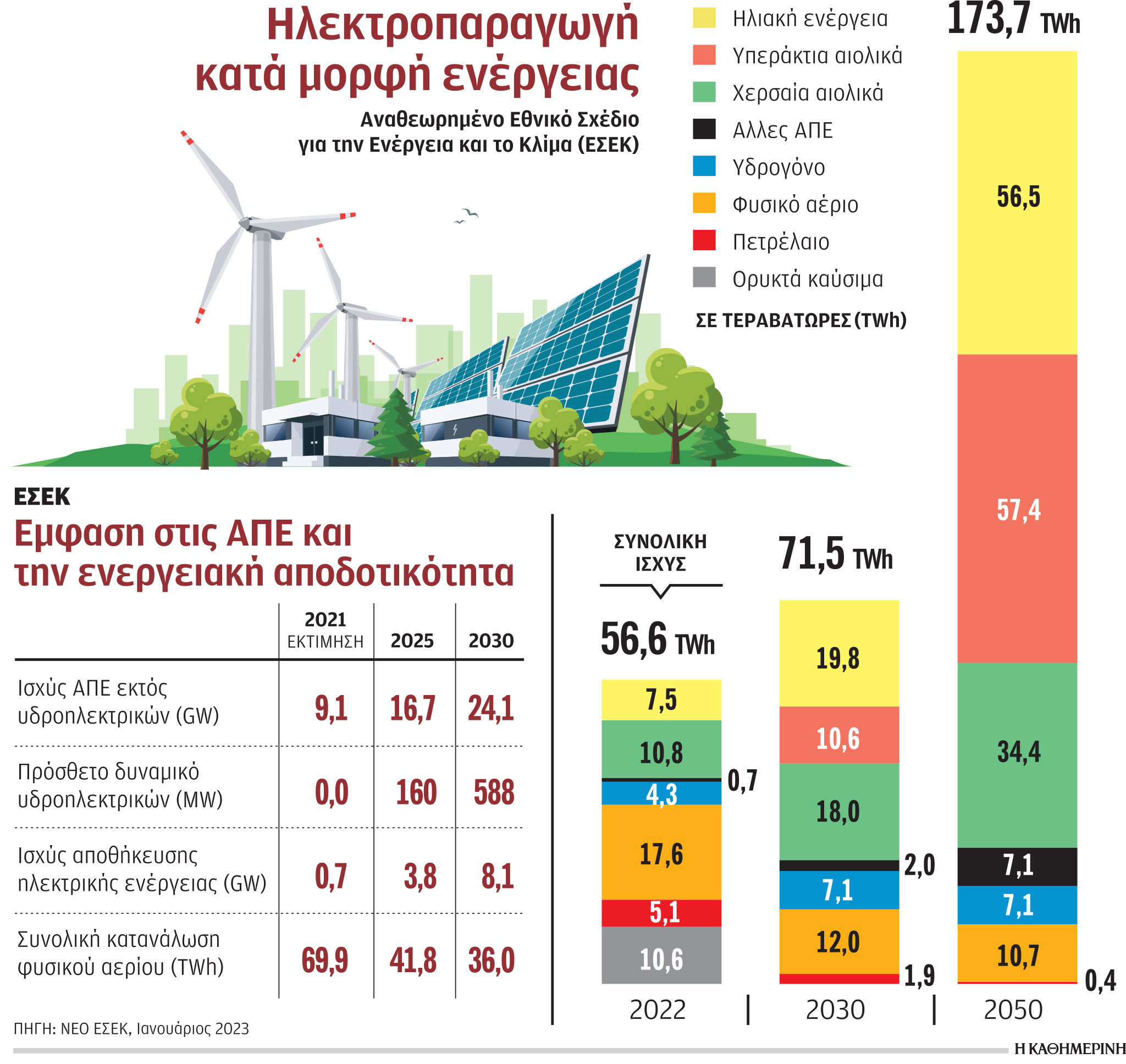
An investment of around 200 billion euros by 2030, which will create 38,000 jobs, National Energy and Climate Plan (ESEK) for “greening” their sectors electricity transport and buildings.
photovoltaics and storage will be the “leader” of green transformation in the electricity sector, while at the forefront offshore wind farms and from 2030 new technologies such as hydrogen and renewable fuelscontributing to achieving climate neutrality by 2050.
gas limit
The pace of development of onshore wind power is slowing down as the limitations of the available space on which such projects can be located and the saturation of the network have been assessed. The participation of natural gas in the energy balance of the country is sharply limited (about 50%), despite the increase in installed capacity for electricity generation by 2 GW until 2030, and the participation of brown coal is reduced to zero.
Interpreting this paradox in relation to natural gas, during yesterday’s presentation at a press conference of the revised ESCE, the Minister of Environment and Energy explained, on the one hand, that the production of natural gas installations will be limited as RES capacity increases, and on the other hand, on the other hand, that new units, as well as the infrastructure built to expand the natural gas network, will be able to operate after 2030 on other fuels (hydrogen, etc.).

The reviewed ESEK introduces for the first time the participation of synthetic fuels in the country’s energy mix with a target of 3.4% in the transport sector in 2030.
It also sets ambitious goals to improve the energy efficiency of the country’s building stock through energy conservation programs and the installation of heat pumps. Only the modernization of buildings provides for investments of 642 million euros per year for the period 2021-2025 and 935 million euros per year for the period 2026-2030.
electromobility
The revised energy and climate plan places particular emphasis on solar energy and energy storage.
Finally, the ambitious targets of increasing the electrification of private vehicles to 20% in 2030 from 3% in 2025 to 85% in 2050 should be noted. From 2035, 1% of private vehicles will run on hydrogen, and this percentage will reach 13%. % in 2050.
“The new proposed ESEK is structured in such a way that it generates added value for the Greek economy and domestic added value, creates new jobs, and with the transformation of the energy sector, we achieve competitive energy prices for all consumers,” said Minister Kostas. Skrekas in the presentation of the plan, which was submitted for public discussion yesterday.
During the press conference and when asked about it, he avoided giving a clear answer on the amount of burden that the implementation of ESEK will fall on consumers, given that a number of investments are being promoted in technology, storage, offshore wind and hydrogen, operational support will continue, additional investments will be required. on the grid (1.2 billion as planned), while natural gas blocks will also need to be subsidized to be viable due to their limited projected operation. “The cost would have been much higher if we had done nothing,” the minister stressed, but he assured that with the achievement of the set goals, electricity prices would drop significantly.
In more detail and according to the new ESCO, in 2030, 80% of electricity is projected to be based on RES against the existing target of 61%, and the reduction in greenhouse gas emissions compared to 1990 is projected at 55%, with energy savings to contribute 6% . From 22% in 2021 and 35% in existing ESCOs, the share of renewables in gross final energy consumption is projected to reach 45% in 2030, above the target of 40% agreed at the European level.
In terms of electricity generation, the country’s installed capacity in 2030 should reach 36.1 GW from 21.6 GW in 2022. This means that an additional 14.5 GW of capacity needs to be installed. Of these, photovoltaics account for the largest part, which is projected to reach 14.1 GW in 2030 and 34.5 GW in 2050 from 5 GW today.
Offshore wind power will add 2.7 GW to the system by 2030 and 17 GW by 2050. Onshore wind power is projected to increase to 7 GW in 2030 and reach 10 GW in 2050 from 5 GW today, while hydropower will to 4 GW in 2030 from 3.2 GW in 2022, with the most important project being the Mesochora hydropower plant, which was unblocked after many years and is in the process of being completed.
Without lignite in 2030
The installed capacity of natural gas power plants from 5 GW today will reach 7 GW in 2030 to return to 5 GW in 2050. in 2050 Lignite contribution is zero in 2030.
Batteries are the backbone
Storage in the form of batteries, hydrostorage and hydrogen is a key element of the new National Energy and Climate Plan (NECP), and the reason for this is that it improves the efficiency of renewable energy sources, since the energy produced when the wind blows and when the sun’s rays can be stored, without loading overloaded networks. The goal is to install a total of 8 GW of storage, of which 2.5 GW from hydrostorage projects, 5.6 GW from batteries and 0.2 million metric tons of hydrogen, which will require 1.2 GW of renewable energy to produce. . 0.2 million tons of synthetic fuel is also added to the storage mix.
Source: Kathimerini
Lori Barajas is an accomplished journalist, known for her insightful and thought-provoking writing on economy. She currently works as a writer at 247 news reel. With a passion for understanding the economy, Lori’s writing delves deep into the financial issues that matter most, providing readers with a unique perspective on current events.